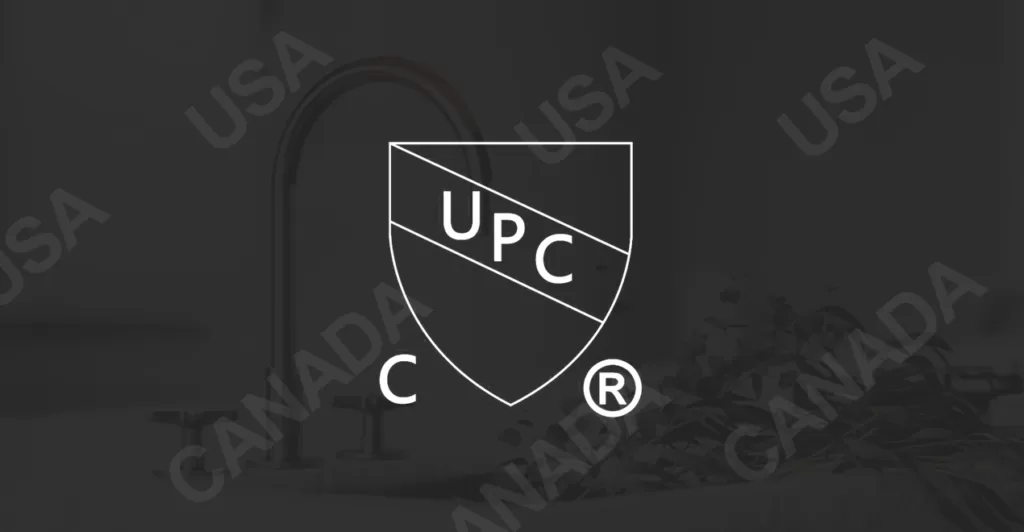cUPC Certified Plumbing Fixture
A lot of people concentrate more on the aesthetic of faucets and fail the most important derivative—checking whether or not a particular faucet meets quality control. It’s imperative that you go for a model that has met quality standards as well as environmental performance. How will users know a fixture has met such standards?

You’ll be able to measure the quality of plumbing products by checking for their certification. Basically, it’s a kind of quality control that a particular country that issues a plumbing product uses to verify compliance with certain standards.
There are various types of faucet certification in the U.S., including cUPC®—a plumbing code given to plumbing products indicating that they’ve complied with Canadian and American plumbing standards. In this article, we explore more about cUPC®, plus why you need to go for premium bathroom faucets that have this certification.
Definition: UPC®/cUPC® Certification
UPC® is an acronym for uniform plumbing code. It’s a listing of requirements and guidelines that the American National Standards Institute curated. The listings was then developed by the International Association of Plumbing and Mechanical Officials.
The uniform plumbing code is revised after every three years under the International Association of Plumbing and Mechanical Officials and the American National Standards Institute accredited development process. Any changes in the plumbing code are then executed by industry experts, including engineers, manufacturers, environmentalists, plumbers, and code officials.
So, what does the ‘c’ in cUPC® stand for? Well, the ‘c’ acronym in your uniform plumbing code suggests that the products have met the American Plumbing Standards and Canadian requirements.
Most faucets will undergo a testing process to verify compliance with uniform plumbing codes. If particular faucet brands pass this testing process, they’re given the go-ahead to display the uniform plumbing code logo on their plumbing products.
As stated early, both marks verify compliance, but there’s a slight difference. The Uniform Plumbing Code mark indicates that a product complies with applicable American codes and standards. On the other hand, the cUPC mark suggests a product is in compliance with applicable American and Canadian requirements and standards.
How Does the UPC Stay Current?
Since it’s a consensus-based document representing a broader range of industries, any change is usually done after the approval of the greater majority. The subject experts representing this broad range must agree by a two-thirds affirmation vote. The diverse stakeholders include engineers, plumbers, code officials, and manufacturers.
A unified-based system is done to ensure that there are no frequent changes on the UPC last minute from any of the single constituencies. This is why the UPC certification is usually designated by the American National Standards Institute. However, changes are always done after every three years. Does IPC goes through the same process as the uniform plumbing code? Well, the International Plumbing Code has a different process.
For one, changes can be made by a single constituency after they provide a proposal—moreover, only code officials at the code final’s development code hearing can vote. Plumbing system experts don’t get to vote on the final hearing. While there are changes to IPC certification every three years, a single stakeholder group vote can create a monopoly which can create last-minute changes.
Buying Fixtures that are (IAPMO) Approved
When you’re buying plumbing fixtures, it’s imminent you ensure the product meets American plumbing standards. Here are a few reasons why you should buy products with uniform plumbing codes.
Ensuring Public Safety
While it may sound cliché to you, buying a fixture in compliance with the UPC certification will ensure safety. Plumbing plays an important role in supplying safe and clean water. And we can’t reiterate much on how safe, clean water affects the day-to-day activities of our lives—from safe drinking water cleaning, as well as comforting baths.
All this shows how important faucets are in safeguarding overall public health. As essential as water is, it’s imminent that we use it in our day-to-day activities without being weary of toxic elements that can enter the water while flowing through the faucet.
When buying faucets, ensuring the product meets the standards for cUPC certification gives you peace of mind as well as your overall optimal safety. This is because the cUPC mark on your faucets tells you that the product meets technical requirements, as it has been tested and certified excellent, not to mention recent quality material standards.
Reducing Costs
The one thing that Faucets with cUPC certification will do for you is reduced energy consumption—who wouldn’t want that? In other words, cUPC faucets are cost-saving. How so?
The faucets address overall water quality and safety concerns, which usually crop up due to aging water in large plumbing systems, as well as offering water and energy efficiency—ensuring that homeowners and building owners save on water, thereby saving on utility costs.
You can easily do this by going to the International Association of Plumbing and Mechanical Officials’ Water Demand Calculator to determine your household consumption. Users can also opt to download the Water Demand Calculator Application or Excel File, where they’ll be able to pick on units for water demands and then conduct the test.
Improving Water or Rather Energy Efficiency
Energy is consumed in every phase of water production as well as the supply chain—the whole process of pumping the water to the treatment area up to the distribution process. When you have an effective plumbing design, residential and commercial properties are able to reduce water consumption and improve energy efficiency.
When you use less water, less water will, in turn, get heated and transported. This will have a ripple effect on the energy consumption and the overall energy bill. Uniform plumbing codes are not just fine prints on your faucets; they mean so much more, as you can see.
Their unified-based certification showing a particular product has built flexibility to adapt to the ever-changing water technologies. Having cUPC or UPC faucets means that they keep in account water and energy efficiency in the supply of water as well as sanitation systems.
Now, let’s look at other labels that have the same meaning as UPC or cUPC mark.
Definition: What Is WaterSense® Label?

There’s another type mark that acts the same way as Uniform Plumbing Code, and cUPC is the WaterSense®. This program was sponsored by the U.S Environmental Protection Agency (EPA) that was created to protect future water supplies through water-efficient products and practices for safety purposes.
Since the program is voluntary, they’re open to working with everyone from manufacturers, retailers, distributors, and irrigation professionals, as well as local and state governments. This encourages more adoption of water-efficient practices, plus quality products in the U.S.
WaterSense® denotes high efficiency and high-quality performance. Faucets with this mark have been certified by the EPA-licensed certifying body. Here are some factors that these certifiers look for.
Water Saving: Providing significant water saving at the national level
Efficiency Differentiation: They’re at least more efficient than their counterparts
Performance: They perform well or better than their less efficient counterparts
Varied Technological Options: Ensures efficiency through various technologies
Now, let’s see which plumbing fixtures can have this type of certification.
What Products Can be UPU, cUPC, or WaterSense® Certified?
Uniform plumbing codes, or WaterSense® labels, can be applied to all plumbing fixtures. Some of the most common fixtures that require these marks include:
Faucets: Most faucets with these marks will use a maximum of 1.5 gallons of water per minute. Others may use a standard of 2.2 gallons of water per minute without compromising quality.
Urinals: They use no more than 0.5 gallons of water per flush. Moreover, they comply with the standard for flashing.
Showerheads: Any type of showerhead that earn these types of logo use 2’5 gallons of water per minute. Additionally, their spray force specifications are sufficient to ensure user satisfaction.
Residential Toilets: These toilets will use 1.28 gallons per flush. This is 20% less than the ordinary standard, usually 1.6 gallons per flush.
Switch to IAPMO Approved Faucets!
Getting faucets that have WaterSense® UPC or cUPC marks is the most efficient way to save water and money. And Infaucets Manufacturers is the right place to buy them. It has evaluated the surrounding world, understanding the need for water conservation.
It has a reputation for providing faucets that have been evaluated and found to meet uniform plumbing code standards. More than that, our faucets go the extra mile to meet also all Canadian requirements—a reason to switch up and buy these fixtures.
Frequently Asked Questions for UPC or cUPC

What is the Difference between UPC and cUPC?
They’re all marks of certification that show that products have followed the right guidelines. But, there have some distinguishing factors. For one, UPC is the standard and usually the only certification required for most fixtures for safety purposes used in the U.S. It includes all the necessary U.S. federal specifications and standards, including ASME/ANSI and NSF.
On the other hand, cUPC is just one of the certifications that are recognized in Canada. This certification includes all federal requirements of Canada as well as America.
Summary
If you want to know about other informations, please click Infaucets. You can learn more knowledge. This also has a large variety of taps to meet any of your clients’ needs

